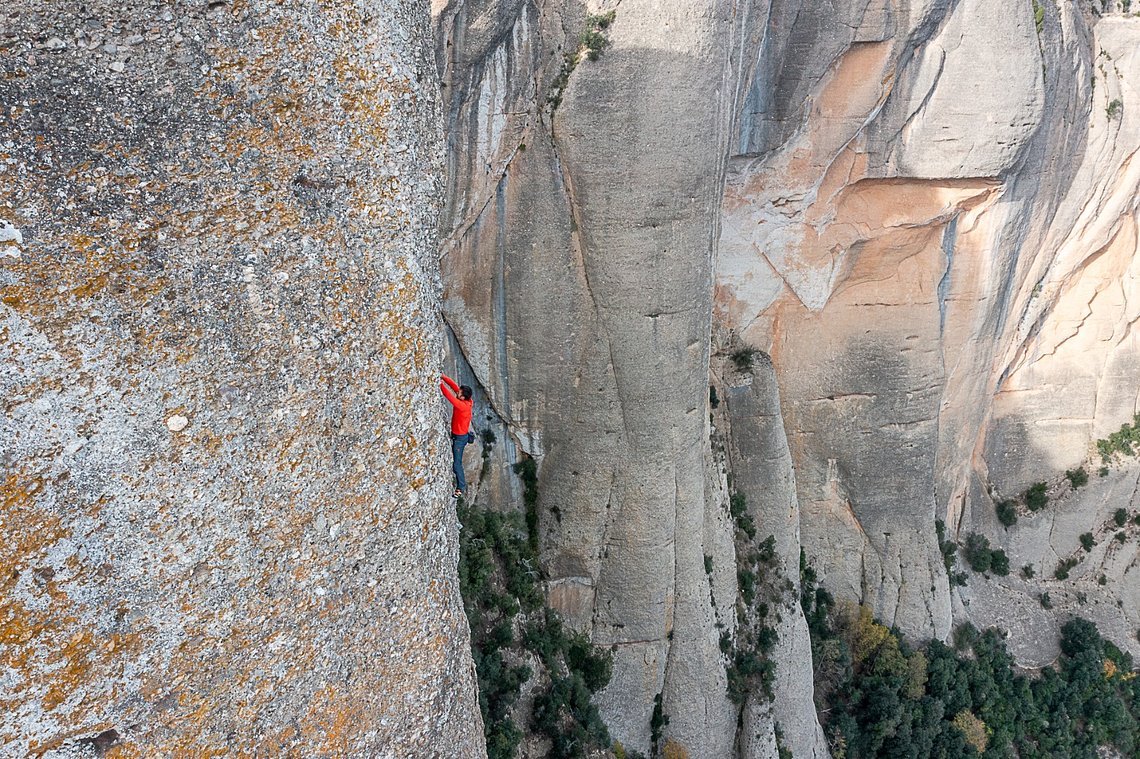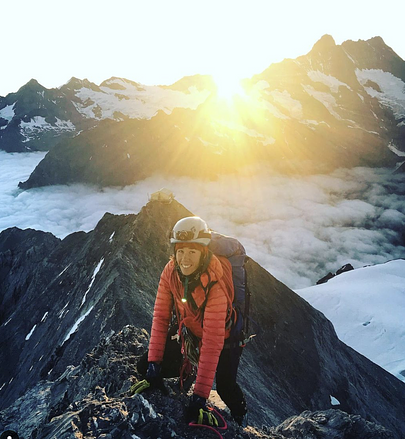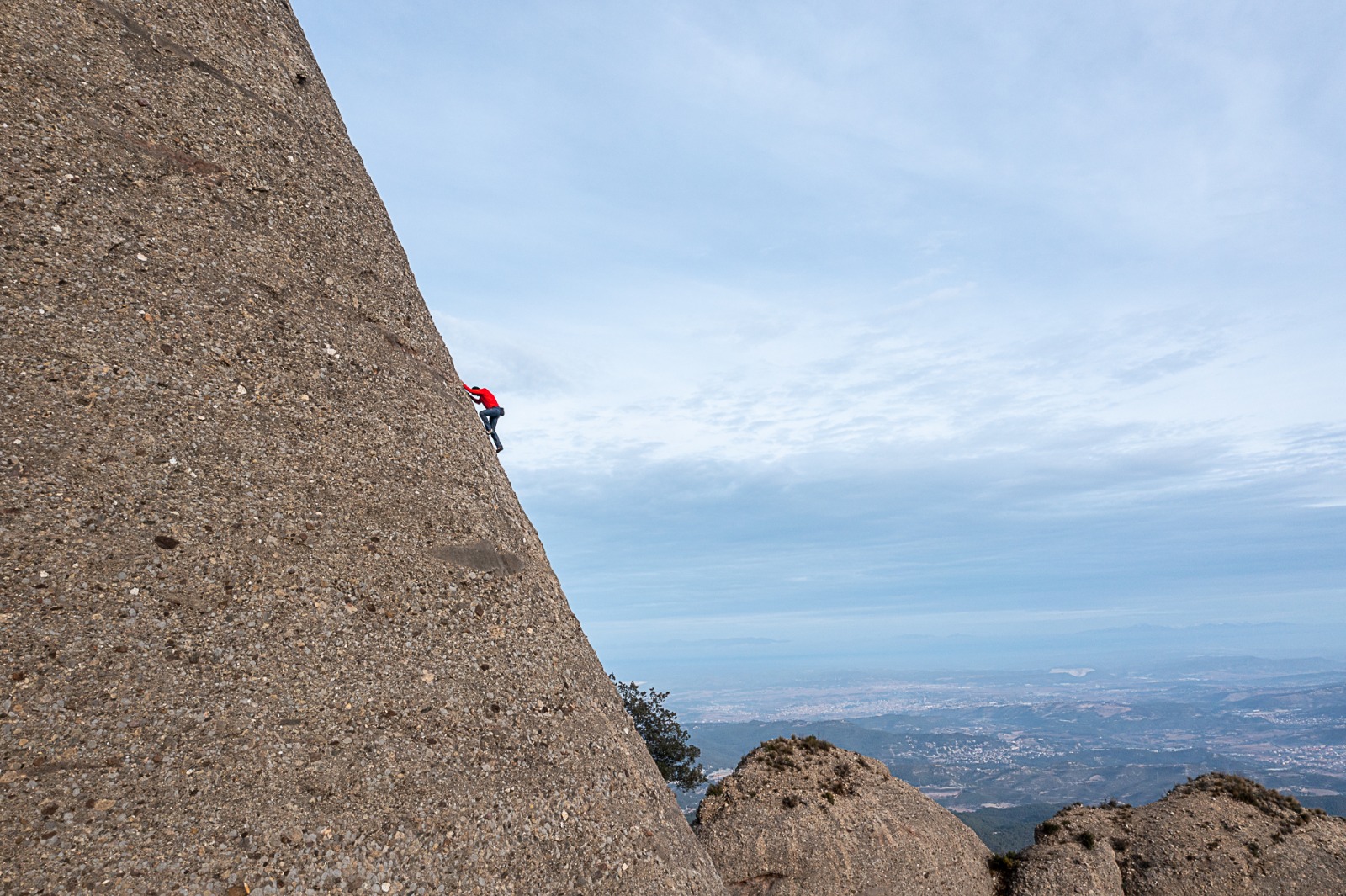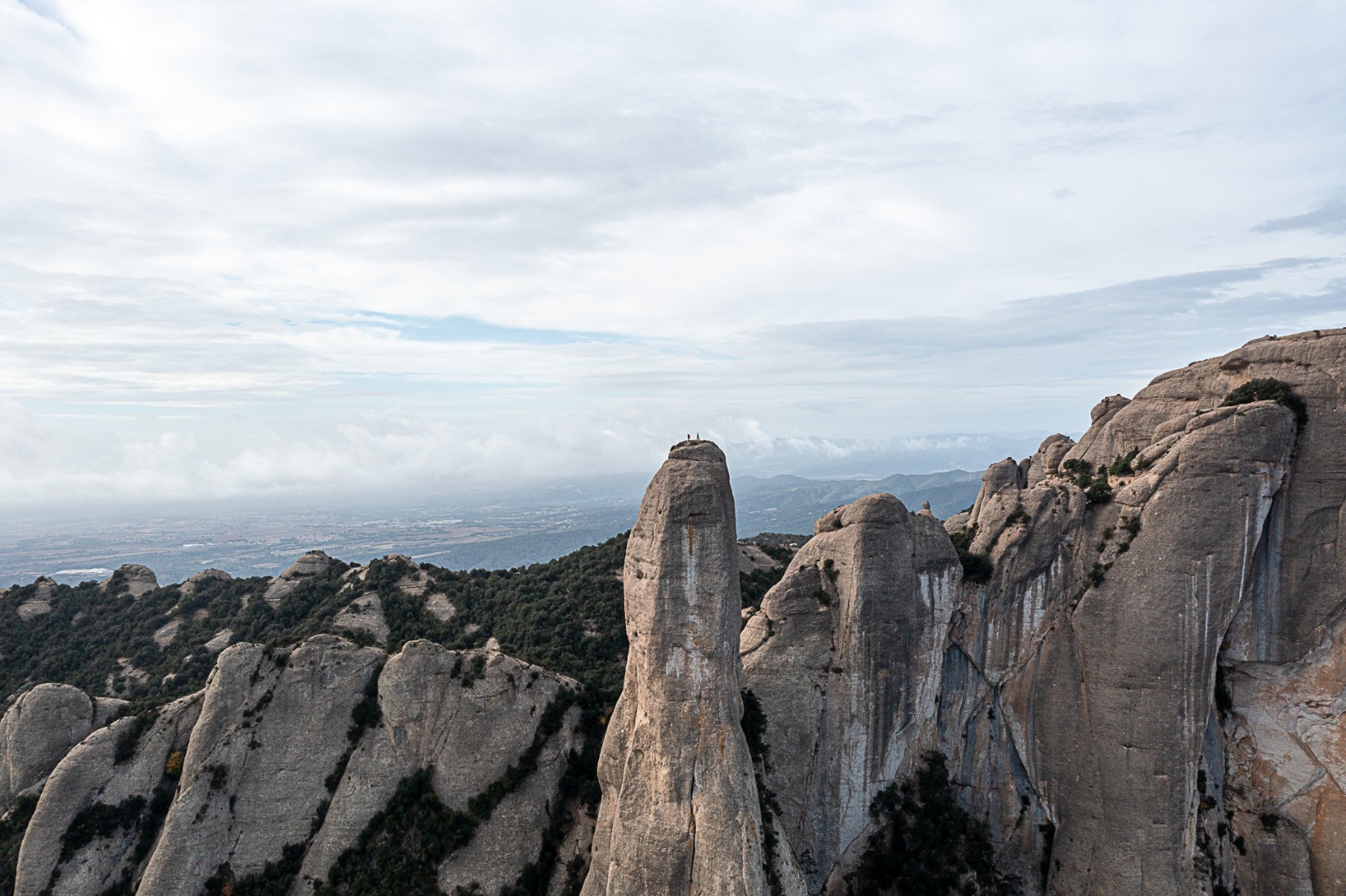Luis Manzaneda climbs free solo 'Punsola-Reniu' (250m 6c) in Montserrat
First free solo ascent of this mythical route in Spain

 by Pat Soler
·
Thu 15 Dec 2022
by Pat Soler
·
Thu 15 Dec 2022
Originally published on Wogu Climb, this is the interview they did with Luis Manzaneda about his free solo at Cavall Bernat in Montserrat. KooKoo Climb had the honor of filming this climb (Video below).
Historical free solo ascent to the most emblematic needle of the Montserrat massif, the Cavall Bernat. Manzaneda had already performed other important solos in the past.
Luis Manzaneda made one of his dreams come true on November 24: free soloing one of the most classic and emblematic routes in the country, the Punsola-Reniu (250m 6c) to Cavall Bernat, in Montserrat. A unique as well as historic ascent. No one had ever climbed this line stablished in 1971 by Manel Punsola and Jesús Reniu in free solo before.
The route, a paradigm of the characteristic Montserrat conglomerate, consists of an initial ramp with four pitches up to V+ and then links three pitches of 6b+, 6c and 6a where the exposure and the void underfoot are brutal, even overhanging in some sections.
Manzaneda devised this ascent as a "round trip", in which after climbing the imposing Punsola-Reniu he downclimbed the regular route (Via Normal). A total of 250 meters of climbing in free solo, mental control and pure flow through one of the most beautiful and emblematic lines of this magical mountain. Luis tells us all the details.
“The idea crossed my mind almost a year and a half ago, after soloing the Easy Rider to Paret de l’Aeri”
Such an ascent is not something that happens from one day to the next. How long have you been planning this climb?
The idea crossed my mind almost a year and a half ago, after also free soloing the Easy Rider to Paret de l'Aeri. I planned to do it in a few months, but for different reasons I postponed it until I finally climbed it on November 24.
How do you prepare for a solo like this?
Physically, what I do is training a bit and go climbing. I ended up repeating the route about seven or eight times in total. In reality, three or four was enough, but I had to postpone the project and return to it months later. After some months I repeated it a few more times to recall the movements and gain confidence. I chose to try it in summer because the days are longer. I would go in alone, late, so as not to disturb any climbers. The first four pitches were climbed without practicing any steps in particular, just paying attention to some sequences. Arriving at the summit, I would fixe a rope and rappelled down to the fifth pitch, 6b+. There I would took off my Grigri and put on a Micro Traxion pulley. I climbed the sequences that interested me the most, always self-belayed on the rope that was coming from the summit. I went up and down as many times as I thought appropriate. Same thing with 6c.
Mentally, I thought a lot about climbing, and I imagined climbing with complete confidence. Sometimes a thought I could slide because somehow my hands or feet would lose the grip and therefore contact with the wall... At that moment I would concentrate more. Doubts and fear arose, but when it happened, I tried to think about my experience, my way of climbing, the confidence that I have always had in myself when climbing and the enormous desire I had to do it and to be there feeling the void. Positive thoughts were always much more powerful than negative ones.
«These towers symbolize like nothing else the essence of climbing because their peaks are only accessible by climbing»
Did a project like this obsess you or motivate you?
It motivated me a lot, although I have to say that having postponed it and taking longer to do it than planned, maybe there were some days that it became a bit of an obsession (laughs). I really wanted to.
 First part, the simplest, of the 'Punsola-Reniu'. Photo / Roger Borrull
First part, the simplest, of the 'Punsola-Reniu'. Photo / Roger Borrull
You said in your Instagram post when you announced the ascent: "It's something that comes from within, that has always been with me [...] The only thing I've done is being consistent with that feeling and let it out." Where does this thought come from?
More than a thought, it is a way of being... and it comes from within. I believe in reincarnation and I think that at the moment of being born "we are already" someone, the only thing that happens is that we do not remember. Therefore, we already have an inertia and we do not begin to "be" at birth. We have always been, from eternity. The preferences and tastes of each person are because we have carried it inside for eons. I am like that, that's how I think and that's how I act because it's what I have inside. All people have their own tastes inside. The nice thing is to discover what they are and let it out.
What sensorial difference do you experience between climbing free solo or rope climbing?
With rope you go calmer and you think less about the movements, even going on sight. Without a string you are more conservative and have to be very careful to use solid hand and foot edges. You can get to flow, but not in the same way that you do with rope. On the other hand, the sensations are much more intense going without a rope. I try to climb relaxed and from time to time I open my focus to look into space and feel what I'm doing. Both in one modality and in the other, I focus on the present moment and do not let any negative thoughts enter.
This is different than climbing with a partner, but... are you ever so involved in climbing that you lose track of time, go on auto mode or feel like time is going at a different speed?
I don't think about time, just what's in front of me. I go from movement to movement, without thinking about anything else, like when I rope climb. Small tensions are created that you have to readjust, but in general I climb relaxed.
«Free Solo climbing will always be seen by a few as crazy and irresponsible»
 The Cavall Bernat from a bird's eye view, with Luis Manzaneda alone at the top. Photo / Roger Borrull
The Cavall Bernat from a bird's eye view, with Luis Manzaneda alone at the top. Photo / Roger Borrull
Climbing without a rope always gives rise to conjectures: "What if they are crazy", "what if they take unnecessary risks", ... Do you think that these comments will end one day and free solo climbing will be more accepted and treated with more "sportsmanship", respect and purity that now?
Absolutely not (laughs). Free solo climbing will always be seen by a few as crazy and irresponsible. Perhaps over time those few will become the majority, since sport climbing is gaining more and more ground, to the point of displacing other styles. Nowadays, people are more aware of safety than a few years back, they want more bolts on the routes and closer to each other. Many classic routes are being re-bolted making them "safer" and the adventure component is suddenly gone. Trad routes become sports, always under the name of safety. As climbing tends to evolve more around safety, slowly free solo climbers will feel more and more outlawed. Derogatory comments will always exist, although it is something that doesn't worry me much.
Perhaps more climbers would free solo if the social pressure wasn't such. It seems that soloists have to hide their consistency when it comes to scaling as they wish to.
I think that climbers who like to free solo continue to do so, even if there is social pressure. Some may not explain anything about their activities because of the criticism they may receive. The funny thing is that the strongest criticism tends to come from the most fearful people with a deep fear of death, who project that fear in the form of harsh criticism. In the end, everyone is free to comment, and to criticize if they want. It is our job to ensure that it does not affect us.
Ropeless ascents have a very strong mental component and the environment plays a fundamental role. I think that in your case it has not been an exception. Who has accompanied you on this journey?
Yes, I have been lucky to be surrounded by a few people who have not only supported me, but who have lived it intensely. For me it has been a gift to see the involvement of each one of them and the joy with which they followed the progress of the project. The truth is that this climb would not have been the same without them and I thank them a lot. To Xavi Coll, the film director, always so positive. To Roger Borrull, a good friend who has taken it upon himself to be the drone pilot. To Juanjo Xaxo, who has lived it intensely from the beginning because he knows what it means to climb without a rope. To Pablo, who offered to come help without hesitation. And above all to Irene, my partner who is always there supporting me in everything I do. She is indeed an example of overcoming. Thank you all.


